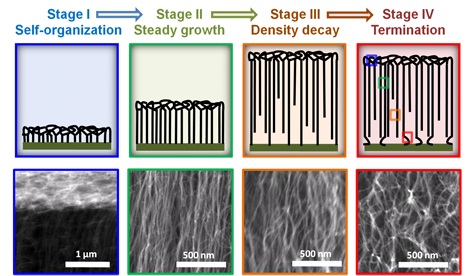
Year
2009Volume
113Issue
48Pages
20576–20582Abstract
We explain the evolution and termination of vertically aligned carbon nanotube (CNT) “forests” by a collective mechanism, which is verified by temporal measurements of forest mass and height, as well as quantitative spatial mapping of CNT alignment by synchrotron X-ray scattering. We propose that forest growth consists of four stages: (I) self-organization; (II) steady growth with a constant CNT number density; (III) decay with a decreasing number density; and (IV) abrupt self-termination, which is coincident with a loss of alignment at the base of the forest. The abrupt loss of CNT alignment has been observed experimentally in many systems, yet termination of forest growth has previously been explained using models for individual CNTs, which do not consider the evolution of the CNT population. We propose that abrupt termination of CNT forest growth is caused by loss of the self-supporting structure, which is essential for formation of a CNT forest in the first place, and that this event is triggered by accumulating growth termination of individual CNTs. A finite element model accurately predicts the critical CNT number density at which forest growth terminates and demonstrates the essential role of mechanical contact in maintaining growth of self-assembled films of filamentary nanostructures.






